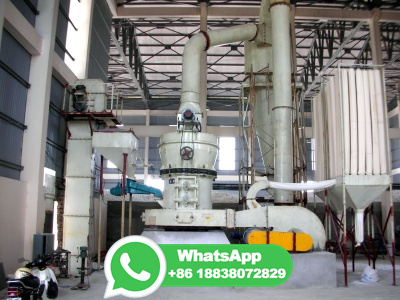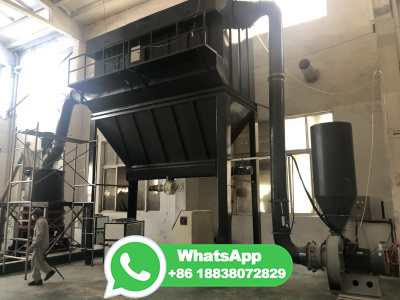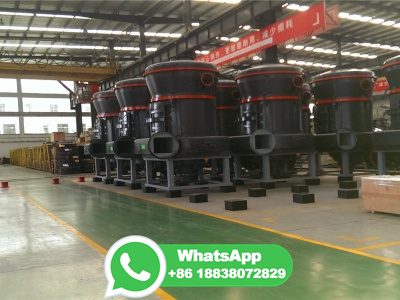
sumption of ball mill for grinding ceramic raw material is less than 80 kW [ 9 ] while a 5 m diameter and m length ball mill consumes MW of power for gold
WhatsApp: +86 18037808511
Materials and Method. Cement ball mill reject sample from a industry located in Pakistan in Pezu District KPK. Study about cement was done for Ordinary Portland cement with 5% gypsum content and 95% clinker. During the sampling time, the capacity of cement mill was 120 t/h and the specific energy utilization was 30 kWh /t and the Mill balls ...
WhatsApp: +86 18037808511
Benzer et al. [21] developed model for open circuit twochamber cement ball mill. In their structure, the first and second chamber of the ball mill as well as the intermediate diaphragm were all model fitted hence calibrated with the experimental data. ... Modeling and simulation of a fully air swept ball mill in a raw material grinding circuit ...
WhatsApp: +86 18037808511
reducing materials to a powder of fine or very fine size. It is distinct from crushing or granulation, which involves size reduction to a rock, pebble or grain size. Milling is used to produce a variety of materials which either have end uses themselves or are raw materials or additives used in the manufacture of other products.
WhatsApp: +86 18037808511
Cement clinker is usually ground using a ball mill. This is essentially a large rotating drum containing grinding media normally steel balls. As the drum rotates, the motion of the balls crushes the clinker. The drum rotates approximately once every couple of seconds. The drum is generally divided into two or three chambers, with different ...
WhatsApp: +86 18037808511
The first step of Cement manufacturing process is to quarry the principal raw materials, mainly limestone, clay, and other materials. Step 2: Crushing. ... and slag for slag cement are all extracted from their respective hoppers and fed to the cement mills. The ball mill grinds the feed to a fine powder in two chambers, namely the first and ...
WhatsApp: +86 18037808511
Cement Ball Mill. Feeding size: ≤25mm. Capacity: /h. Functional advantages: Uniform abrasive, low energy consumption. Applications: Mainly used in cement plant, building materials, metallurgy, electric power and chemical industry, grinding all kinds of cement clinker and other materials. Email: info
WhatsApp: +86 18037808511
Steel balls are one of the most widely used grinding media in cement ball mills, their diameters can range from 20mm to 120mm according to different grinding requirements. In a cement ball mill, generally, φ50100mm steel balls are used in the coarse grinding chamber, φ2050mm steel balls are used in the fine grinding chamber. 2.
WhatsApp: +86 18037808511
Raw Ball Mill by BNN—A "Conscious Lab" Approach. Materials 2021, 14, 3220. https:/// /ma Abstract: In cement mills, ventilation is a critical key for maintaining temperature and material transportation.
WhatsApp: +86 18037808511
grinding the cement clinker nodules to passing 90 μm in a dry circuit. Grinding occurs at the beginning and the end of the cement making process. Approximately tonnes of raw materials are required to produce 1 tonne of finished cement. The electrical energy consumed in the cement making process is in order of 110 kWh/tonne and about ...
WhatsApp: +86 18037808511
A review of recent raw mill designs indicates that increasing the maximum design raw material moisture from 4% to 17% would result in a doubling of the installed fan capacity. The separator size ...
WhatsApp: +86 18037808511
1. According to raw material processing options. In the operation, if the raw material that the user needs to process is tungsten tin ore, the rod mill is a better choice, and if the material to ...
WhatsApp: +86 18037808511
If the ball milling time is too long, the agglomeration effect occurs and the activity will also be reduced. The ball milling sequence refers to the feeding sequence of raw materials. The feeding sequence affects the mechanochemical effect of raw materials in the ball mill pot, thus affecting the performance of AASB.
WhatsApp: +86 18037808511
14 Cement Mill and Bag House . Clinker, along with additives, is ground in a cement mill. The output of a cement mill is the final product viz. Cement. In a cement mill, there is a cylindrical shell lying horizontal which contains metallic balls and as it rotates, the crushing action of the balls helps in grinding the clinker to a fine powder.
WhatsApp: +86 18037808511
Cement Manufacturing Process Phase 1: Raw Material Extraction. Cement uses raw materials that cover calcium, silicon, iron and aluminum. Such raw materials are limestone, clay and sand. Limestone is for calcium. It is combined with much smaller proportions of sand and clay. Sand clay fulfill the need of silicon, iron and aluminum.
WhatsApp: +86 18037808511
Features of vertical cement mill. Vertical mill can dry and grind materials with moisture up to 10% at the same time; Vertical mill has simple processing, compressed structure and small building space. The floor area of vertical mill is 70% of ball mill. Building space is 60% of ball mill system. Outdoor arrangement can directly decrease the ...
WhatsApp: +86 18037808511
1. Introduction. Airswept raw meal ball mills introduced by the cement mill manufacturers ® (, 2002), Polysius ® (Polysius, 2002) and KHD Humboldt Wedag® are the most commonly used Humboldt Wedag® manufactured fully airswept raw meal mills which have two compartments used for drying and grinding processes.
WhatsApp: +86 18037808511
In this chapter an introduction of widely applied energyefficient grinding technologies in cement grinding and description of the operating principles of the related equipments and comparisons over each other in terms of grinding efficiency, specific energy consumption, production capacity and cement quality are given.
WhatsApp: +86 18037808511
cement ball mill Application: limestone, clay, coal, feldspar, calcite, talc, iron ore, copper, phosphate, graphite, quartz, slag. Capacity: .65615T/H
WhatsApp: +86 18037808511
A ball mill is a cylindrical device used in grinding materials like ores, alloys, coal, coke, fibers, cement clinker, refractory material, ceramics, limestone, quartz, gypsum, metal oxides, slag ...
WhatsApp: +86 18037808511
Raw mill SEC (kWh/kgmat'l) Addition of Grinding Balls Watch raw mill SEC daily and add grinding balls in right timing →10% energy saving expected Ball diameter shrinks as time passes due to erosive effect. This leads to gradual increase of raw mill SEC. Filling level of grinding balls is also important in
WhatsApp: +86 18037808511
Introduction of cement ball mill. Cement ball mill is a kind of equipment for fine grinding of materials. It is a device for the next step of fine grinding of coarsegrained materials. It can ...
WhatsApp: +86 18037808511
1. Introduction In the cement industry, grinding is one of the most consuming energy stages in the production units. Around 65% of the total used electrical energy in a cement plant has to be utilized to grind raw materials, coal, and clinker [ 1, 2 ].
WhatsApp: +86 18037808511
In the wet process of cement production, raw materials should be ground into raw slurry with a water content of 30% 40%. While in the dry process of cement production, they will be ground into dry powder in cement raw mill. Raw mill in the dry process: cement ball mill, cement vertical mill, Raymond mill, etc.
WhatsApp: +86 18037808511
Abstract. Cement sector in india is enjoyign success and capacity enhancement due to the rapidly growing demand in various sectors but at the same time a threat is approaching to cement industry that its input cost is increasing day by day like power cost, fuel cost, raw material cost. Also cement is a highly energy consuming industry.
WhatsApp: +86 18037808511
Ball mills for cement raw material and coal equipped with a drying compartment adequately air swept with hot gas (/sec above the ball charge), can handle moisture about 8%. Fully air swept mills (56M/sec) can dry up to 1214% moisture.
WhatsApp: +86 18037808511